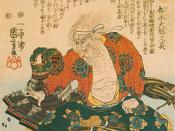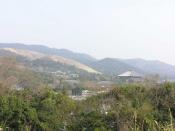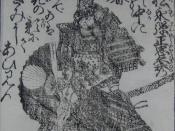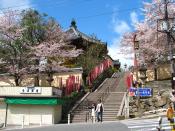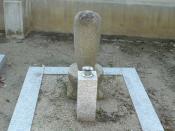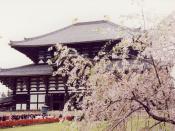Primitive In stone age, people apparently processed sanukaito (sanuki stone:very hard, sharp cut end) by utilizing that stones available at the foot of Nijo mountain, they used it for hunting and exchanged it around Kinki area commercially. Recently, early jomon era styled archeological living site were excavated in Yamazoe mura, Yamabe gun, in Nara basin where mostly wetland, people moved outat the end of Jomon era to reside comfortable place for hunting and collecting for living. Around B.C.3, the cultural Yayoi immigrated with the knowledge of rice crop from continent and started rice field cultivation by taking advantage of wetland in Nara basin. It is considered that Karako, Kagi at Tawaramoto cho must be archeological village site of those days.
Ancient Around the end of 3 C to early 4C, huge zenpokoenfun(half square half round shaped tomb) was made at the foot of Miwa mountains, east Nara basin. It is said that those are graves for old clans, mainly for emperor in Yamato who intend to unite the whole nation.
Around the end of 4C to 5C, huge zenpokoenfun can be seen around north and west of the basin. The series of Saki kofun (Nara city) and umami hill land kofun (Koryocho, Kawaicho) are famous. In 6C., one of the political clans, Sogashi who had strong connection with immigrants transferred the basis to Asuka, supported Buddhism which came from continent by making relatives with Royal family. Eventually, Buddhist culture was in bloom around Asuka district and Ikaruga district where Horyuji temple was constructed. Shotokutaishi titled sessho who had strong connection with Sogashi governed, and sent Ononoimoko to Zui as a diplomatic personnel, but after his death, the law system based on Zui and To was granted through the innovation of Taika, capital city of Fujiwara (Kashihara city) was built where surrounded by Yamato sanzan through war of Jinshin. After that, the capital city of Heijo (Nara city) was built in north basin to enhance the political power, the new city constructed was based on Choan, the capital city of To. Many of temples in Asuka and Fujiwara kyo were also transferred to Heijo kyo, Kofukuji temple and Todaiji temple were constructed at the east of new capital.
As you can see many of historical assets in shosoin, Tenpyo culture is very international. In 794, since the capital city was transferred to Heian kyo(Kyoto city), atmosphere of Yamato disappered with the aristocrats, as"the south capital", Nara was crowded with people who visited temples.
Medieval In Heian era, in the mean time Nara city was away from center of politics, conflict of Genji family and Heishi family got worse, Todaiji temple and Kofukuji temple were burnt out by Heishi, together with army raised by Minamoto yoritomo.
Soon after Minamoto yoritomo who established government in Kamakura supported shrines and temples in south city, patronized a sect of Unkei and Kaikei who are sculptors of Buddhism image, eventually powerful arts like the two Deva Kings statue in front of Todaiji Nandaimon gate were left to us today. At the end of Kamakura era, the conflict between south capital and north capital broke up, Yamato was involved in politics again due to the establishment of the government in Yoshino mountain (Yoshino cho) in south capital side.
In Muromachi era, the local clans in Yamato turned out to be warriors called public or citizen, and they participated in the war of Onin, Kyoto. On the other hand, the establishment of Yamato sarugakushiza (origin of nogaku) and Wabicha(established by Murata Juko) symbolizes high standard culture of those days. In turbulent era, a sect of ikko became bigger with public support, they started riot and burnt Kofukuji temple, they made Jinaicho at Imai(Kashihara city), Takada (Yamatotakada city) and Tawaramoto(Tawaramoto cho). The tail wags the dog started in Yamato, Matsunaga hisahide and Tsutsui Junkei based Shigi mountain castle and Tamon mountain castle became influential and started confliction. Daibutsuden of Todaiji temple was damaged by that. Matsunaga hisahide was killed by Oda Nobunaga who hoped to unite the nation, Yamato was to be governed by Tsutsui Junkei who followed after Nobunaga. However, after the death of Nobunaga, Toyotomi Hideyoshi who achieved uniting the nation assigned his brother Hidenaga to be in Koriyama castle(Yamatokoriyama city).
Hidenaga prohibited business away from Koriyama, practiced land inspection, forced Yamato into a frame of feudal system.
